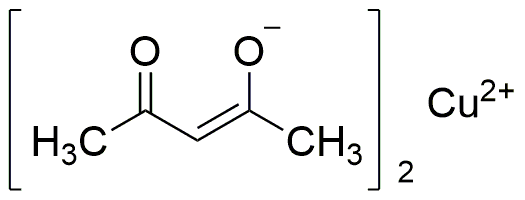Bis(2,4-pentanedionato)copper(II) is widely utilized in research focused on:
- Catalysis: This compound serves as an effective catalyst in various organic reactions, enhancing reaction rates and selectivity, which is crucial in the development of pharmaceuticals and fine chemicals.
- Material Science: It is used in the synthesis of copper-based nanomaterials, which have applications in electronics and sensors due to their excellent electrical conductivity.
- Analytical Chemistry: The compound acts as a reagent in analytical techniques, aiding in the detection and quantification of metal ions in environmental samples, thus supporting environmental monitoring efforts.
- Biological Studies: Researchers utilize it to investigate the role of copper in biological systems, contributing to studies on enzyme activity and potential therapeutic applications in treating diseases related to copper metabolism.
- Coatings and Pigments: This chemical is incorporated into coatings and pigments, providing antimicrobial properties and enhancing durability, making it valuable in the manufacturing of paints and protective coatings.
General Information
Properties
Safety and Regulations
Applications
Bis(2,4-pentanedionato)copper(II) is widely utilized in research focused on:
- Catalysis: This compound serves as an effective catalyst in various organic reactions, enhancing reaction rates and selectivity, which is crucial in the development of pharmaceuticals and fine chemicals.
- Material Science: It is used in the synthesis of copper-based nanomaterials, which have applications in electronics and sensors due to their excellent electrical conductivity.
- Analytical Chemistry: The compound acts as a reagent in analytical techniques, aiding in the detection and quantification of metal ions in environmental samples, thus supporting environmental monitoring efforts.
- Biological Studies: Researchers utilize it to investigate the role of copper in biological systems, contributing to studies on enzyme activity and potential therapeutic applications in treating diseases related to copper metabolism.
- Coatings and Pigments: This chemical is incorporated into coatings and pigments, providing antimicrobial properties and enhancing durability, making it valuable in the manufacturing of paints and protective coatings.
Documents
Safety Data Sheets (SDS)
The SDS provides comprehensive safety information on handling, storage, and disposal of the product.
Product Specification (PS)
The PS provides a comprehensive breakdown of the product’s properties, including chemical composition, physical state, purity, and storage requirements. It also details acceptable quality ranges and the product's intended applications.
Certificates of Analysis (COA)
Search for Certificates of Analysis (COA) by entering the products Lot Number. Lot and Batch Numbers can be found on a product’s label following the words ‘Lot’ or ‘Batch’.
Numéro de catalogue
Numéro de lot/série
Certificates Of Origin (COO)
This COO confirms the country where the product was manufactured, and also details the materials and components used in it and whether it is derived from natural, synthetic, or other specific sources. This certificate may be required for customs, trade, and regulatory compliance.
Numéro de catalogue
Numéro de lot/série
Safety Data Sheets (SDS)
The SDS provides comprehensive safety information on handling, storage, and disposal of the product.
DownloadProduct Specification (PS)
The PS provides a comprehensive breakdown of the product’s properties, including chemical composition, physical state, purity, and storage requirements. It also details acceptable quality ranges and the product's intended applications.
DownloadCertificates of Analysis (COA)
Search for Certificates of Analysis (COA) by entering the products Lot Number. Lot and Batch Numbers can be found on a product’s label following the words ‘Lot’ or ‘Batch’.
Numéro de catalogue
Numéro de lot/série
Certificates Of Origin (COO)
This COO confirms the country where the product was manufactured, and also details the materials and components used in it and whether it is derived from natural, synthetic, or other specific sources. This certificate may be required for customs, trade, and regulatory compliance.

